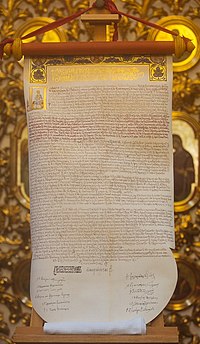Tomos (Église orthodoxe)
Un tomos (en grec : τόμος) dans l'Église orthodoxe est un décret du Primat d'une Église orthodoxe particulière sur certaines questions (telles que le niveau de dépendance d'une église par rapport à son Église Mère)[1].

Tomos est un mot grec qui peut être traduit littéralement par "une section". Dans le sens plus précis de la terminologie utilisée par l'Église orthodoxe, un Tomos est un rouleau ou un petit ouvrage avec un but très précis ; il codifie une décision du Saint Synode ou d'un Concile d'évêques orthodoxes[2]. La traduction du mot tomos en anglais est document[3].
Références
modifier- (en) Cet article est partiellement ou en totalité issu de l’article de Wikipédia en anglais intitulé « Tomos (Eastern Orthodox Church) » (voir la liste des auteurs).
- Victor Roudometof, Globalization and Orthodox Christianity: The Transformations of a Religious Tradition, Routledge, (ISBN 978-1135014698), p. 173
- Talant, « Ukraine's word of 2018: Tomos », KyivPost, (consulté le ) : « The word is 'tomos,' and it was one of the most searched words on Google in Ukraine this year. In Greek, it literally means 'a section' and is related to the verb 'to cut.'
By extension, it came to refer to a section of a papyrus scroll, on which books used to be written, and then to a volume of a book, which is where we also get the English word 'tome'. [...]
In the narrower meaning in Orthodox church terminology, a tomos is indeed a scroll or a small book, but one with a very specific purpose — it codifies a decision by a holy synod, or council of Orthodox bishops. » - (en) Casper, « From Russia, Without Love: Ukraine Marks Orthodox Christmas with Biggest Schism Since 1054 », Christianity Today, (consulté le )